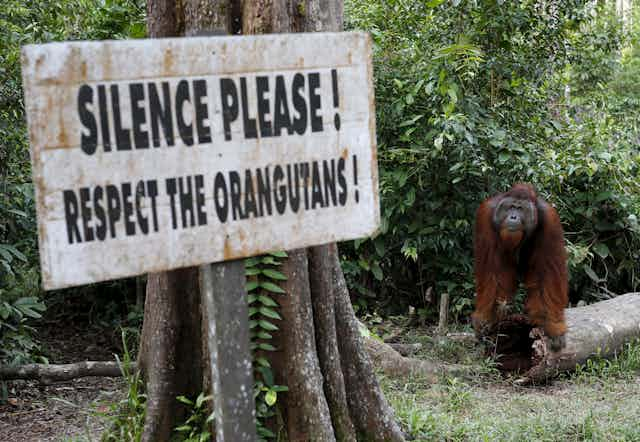Orangutans are often more popular on the internet than in their native forests. Online, their attractive faces, fluffy bodies and swinging abilities make them perhaps the most shareable of all the great apes. But back in Borneo and Sumatra, where local populations are more ambivalent about orangutans, the situation is less straightforward.
The third annual International Orangutan Day was held in August: a celebration of all things orangutan which aimed to highlight their crisis and encourage public action. For 24 hours, orangutan conservation organisations filled Facebook and Twitter with images, trivia and calls to save the rainforests of Borneo and Sumatra – their only home. People donated to charities, signed petitions, liked, tagged, shared and retweeted content, posted supportive selfies and even organised local gatherings to mark the day.
This was just one of many digital entry-points that has made orangutan conservation an increasingly accessible, everyday affair. Today, one doesn’t need to gain a PhD, spend months in the jungle or stage Greenpeace-style confrontations to help save orangutans. Thanks to digital technology and social networking, ordinary members of the public can do their bit.
The dominant narrative portrays orangutans as being pushed to the brink of extinction by deforestation and the expansion of oil palm plantations. This is often illustrated by a colourful cast of both stereotypical characters – the majestic, handsome male, the loving mother and the cute baby – and individual personalities such as Budi and Jemmi, two orphans in Sumatra whose adventures have been avidly followed across Facebook, Twitter and their rescue centre’s website.
These charismatic creatures bring a powerful immediacy and reality to the dominant narrative. Through them, an account of environmental destruction and species loss is turned into a series of gripping stories and personal tragedies: the innocent babies who have lost their mothers, the formidable male left helpless by chainsaws, the “saved” victims in need of help.
Not simply animals or scientific specimens, these orangutans are the very faces of the rainforest – threatened by appropriately large, faceless villains. As such, they’re immensely powerful magnets of public affection, support and funding.
The other faces of orangutan conservation
In the midst of all this, however, some other faces and voices remain hidden. Among them are the people who live alongside orangutans in Borneo and Sumatra.
Many orangutan conservation bodies work closely with local partners and communities. But these collaborations tend to receive far less attention in online conversations and popular perceptions of the orangutan “crisis”. And when local communities do appear in conservation material, they’re often cast as either victims of deforestation or as “ecologically noble” allies who simply need to be educated about conservation.
But as any anthropologist would point out, real life is far more complicated than that. Even the most exotic groups have internal divisions, ambitions, political leanings and ethical dilemmas. Not everybody is an instinctive defender of the forest or subscriber to Western conservation values.
Indeed, many rural Borneans are understandably more concerned about obtaining development and guarding their livelihoods – from crop-raiding orangutans, for instance – than the rather vague idea of saving the environment. And as recent research has shown, humans and orangutans are not always natural bedfellows. Hunting and conflict-related killing have also contributed to the decline of orangutan populations in recent decades.
Such findings don’t make for easy reading, not least because they reveal the complex humanity of Bornean and Sumatran populations. Like orangutans, these rainforest dwellers also have a vital stake in the fate of their environment – but in ways that can challenge the black-and-white morality of the dominant conservation narrative.
Only a small minority of these voices are currently part of digital conversations about orangutan conservation. But if orangutan conservation goals are to be realised, these local faces and voices can’t be glossed over. Rather, they need to be more carefully integrated into the dominant narrative – while ideally helping to transform it.

